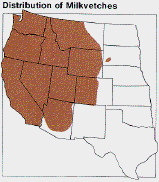 About half of the Astragalus species contain notrotoxins (NPA, NPOH). These include plants such as Wasatch milkvetch, Columbia milkvetch, Yellowstone milkvetch, red stemmed pea vine, and other species and varieties of Astragalus. Cattle of all ages are highly susceptible to the poisoning. Even when other forage is available, cattle readily eat milkvetch. About half of the Astragalus species contain notrotoxins (NPA, NPOH). These include plants such as Wasatch milkvetch, Columbia milkvetch, Yellowstone milkvetch, red stemmed pea vine, and other species and varieties of Astragalus. Cattle of all ages are highly susceptible to the poisoning. Even when other forage is available, cattle readily eat milkvetch.
Plants are poisonous from the time they emerge until they dry up in late summer or are killed by frost. Milkvetch poisoning may be mistaken for larkspur poisoning. Wasatch milkvetch is a perennial that is found on rolling hillsides above 200 meters. It grows 15 to 25 cm high. Flowers of Wasatch milkvetch resemble sweet peas. They vary in color from creamy white to shades of violet. The poisonous substance in Wasatch, Yellowstone, and Columbia milkvetch is the b-D-glucoside of 3-nitro-1-propanol, or miserotoxin. Other milkvetches contain glucosides of 3-nitropropionic acid which are metabolized to toxic 3-nitro-1-propanol. Toxicity is caused by both inhibition of cellular metabolism and nitrite oxidization of hemoglobin. Over 260 North American Astragalus species and varieties contain varying amount of these nitro-toxins.  Where and When it Grows Where and When it Grows
Milkvetches grow throughout much of North America. Most of the poisonous species grow on the meadows and forests of the Rocky Mountain States and in the semiarid regions of the Southwest. Milkvetches emerge from late April to June, depending on elevation and snowmelt. As plants mature and dry, they decrease in toxicity until they are nontoxic when they are dry.
How it Affects Livestock
Cattle, horses, and sheep have been poisoned. Poisoning results in pulmonary emphysema (commonly seen in sheep) and spinal cord demyelination (commonly occurs in cattle). Milkvetch toxins act quickly with most animals that ingest lethal doses dying in 4-25 hours. One kg of green milkvetch may be a lethal dose for a 500-kg cow. Animals that die quickly may not show clinical signs; but more often, animals die within 3 or 4 hours after eating the plant. These acutely poisoned animals generally show muscular weakness progressing to paralysis such that affected animals fall after the slightest excitement. The heart rate is often extremely high. Although they appear bright, they quickly die. The exact cause of death in these cases has not been determined, but it is thought to be caused by the milkvetch toxin's fatal cardiovascular effects. Chronic intoxication most often occur in cattle and sheep from grazing any of the toxic varieties of Astragalus slowly over a period of several days or weeks. Poisoned animals generally have respiratory problems and varying degrees of posterior paralysis. These animals develop extensive pulmonary emphysema and demyelination of the posterior spinal cord. This condition occurs in most of the Western States and western Canada. Signs and Lesions of Acute Poisoning Severe respiratory distress Muscular weakness primarily in pelvic limbs; prostration Death usually occurs in 3 to 4 hours Lobular alveolar emphysema; lungs collapse and constricted bronchioles with
interlobular edema Signs and Lesions of Chronic PoisoningNervousness Labored, rapid respiration As intoxication progresses, respiration develops a wheezing or roaring sound Knuckling of fetlocks Goose stepping, knocking of hocks and/or feet when walking Drooping of pelvic limbs and loss of control of hind limbs; may be dragged when
animal moves Indications of temporary blindness Drooling; rough hair coat; constipation or diarrhea may occur When forced to move rapidly, animal may collapse and die Lactating cows more commonly affected than nonlactating Animals with advanced poisoning seldom recover but commonly waste and die after
several months Sheep show more respiratory and less neuromuscular involvement Horses can be intoxicated Focal hemorrhages in brain Wallerian degeneration in spinal cord in pelvic region Alveolar emphysema, interlobular edema How to Reduce Losses
Prevent animals from grazing these plants in their early growth when toxin level is high and following rain, which increases plant metabolism. There is no known treatment for milkvetch poisoning. Milkvetches can be controlled with 2,4-D (1 kg ae/Ac), picloram or clopyralid (100 gm ae/Ac), and metsulfuron (10 gm ai/Ac) are effective. Treat plants before they reach full bloom. Follow all precautions for handling herbicides. | 

 About half of the Astragalus species contain notrotoxins (NPA, NPOH). These include plants such as Wasatch milkvetch, Columbia milkvetch, Yellowstone milkvetch, red stemmed pea vine, and other species and varieties of Astragalus. Cattle of all ages are highly susceptible to the poisoning. Even when other forage is available, cattle readily eat milkvetch.
About half of the Astragalus species contain notrotoxins (NPA, NPOH). These include plants such as Wasatch milkvetch, Columbia milkvetch, Yellowstone milkvetch, red stemmed pea vine, and other species and varieties of Astragalus. Cattle of all ages are highly susceptible to the poisoning. Even when other forage is available, cattle readily eat milkvetch.
 Where and When it Grows
Where and When it Grows